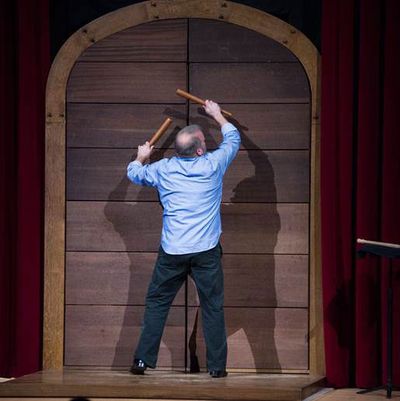
Some iconoclastic artists eventually adapt to the system; others defy it; still others ignore it completely. Karlheinz Stockhausen was the rare composer who made institutions contort to fit his imagination. His music demanded miles of cable, acres of space, custom electronic instruments, and, in one case, a caged wild bird. He found governments and presenters happy to provide them all. His seven-opera cycle Licht involves placing multiple orchestras and choirs in different halls. The Cologne Opera built two theaters inside an exhibition hall. A string quartet in a helicopter? Done.
Stockhausen died in 2007, and his final and unfinished work, Klang, is a cakewalk by comparison: a 21-hour cycle of pieces, each one requiring a different configuration of performers. Even so, its U.S. premiere had to wait for a cultural juggernaut eager for a fresh challenge. The Metropolitan Museum of Art, which has just opened Met Breuer, celebrated its physical expansion with a long exhalation of Klang. And so, on a bright spring Saturday, I followed the ley lines connecting the Met’s three branches, beginning with an 11 a.m. performance of Hour 1, “Himmelfahrt” (“Heavenward Journey”), in the Fuentidueña Chapel at the Cloisters. It felt a little early in the day for a 45-minute organ ritual, in which the soloist, Taka Kigawa, occasionally paused the clotted flow of notes, took up a mallet, and struck a gong or a bell. Periodically, a tenor and soprano interjected an impatient “Gott!” The music clattered off the chapel’s stone walls.
Stockhausen’s music often sounds patched together with bungee cords and safety pins, and so do the philosophical and religious ideas behind it. Yet he was a master of orderly madness, planning his works with a technical precision that keeps his fans absorbed in deciphering their construction. His scores are visual artworks, multicolored, elaborate cryptographs that winnow out all but the most devoted performers. He could be prolix and sporadically captivating: You never know when some moment of sonic magic will emerge from the grandiose rattletrap. Presenters sometimes take a sacramental approach to Stockhausen’s large-scale spiritual theatrics, but Klang is a collection of long-winded miniatures, and the Met’s music producer Limor Tomer wisely inserted them into the ordinary hum of the museum’s life. At the Cloisters, people followed their ears to the chapel and either stayed or wandered away. (Mostly they stayed, so the staff hurriedly added more chairs.) Later, at the Fifth Avenue mothership, visitors wandering through the Arms and Armor Court had to squeeze by the piano where Yukiko Takagi was performing Hour 3, “Natürliche Dauern” (“Natural Durations”). Great metallic chords struck in the marble hall, dying into the ambient hum. At the Met Breuer, the cloud-tearing angel-calls of “Erwachen,” for soprano saxophone, trumpet, and cello, sliced through the din from the café beyond the curtains.
It’s hard to gauge how many Stockhausenites bounced among the various Mets, plotting routes to maximize the number of separate musical “hours” they could take in. Nobody could logistically manage them all, but my colleague Zachary Woolfe at the Times clocked 17; I honor his sitzfleisch. Two pieces strike me as essential. One is “Cosmic Pulses,” (Hour 13), a multilayered work of chattering electronics that Stockhausen deconstructed and repurposed as accompaniments for an assortment of soloists. The second is “Himmels Tür” (“Heaven’s Gate”), which at first seems to present the simplest of low-tech setups: one musician, cudgeling a wooden door with a pair of heavy sticks. And yet Stuart Gerber summoned such a colorful orchestra of sounds from the 12 panels of different woods and thicknesses that the door seemed to be speaking in tongues. He tapped, hammered, leapt, stomped, and panted in a routine of gradually intensifying virtuosity and passion. For all of Stockhausen’s deadpan severity, this is a depiction of pure physical and spiritual desire, which the composer gratifies in his own mysterious way. The door finally opens and the player walks through — to an offstage apparatus of cymbals and sirens that make a savage new din. Then a little girl gets up from the audience and walks onstage and silently through the door. On a day of haphazard encounters and musical migrations, her silent exit — or was it an entrance? — had the power of a major event.





